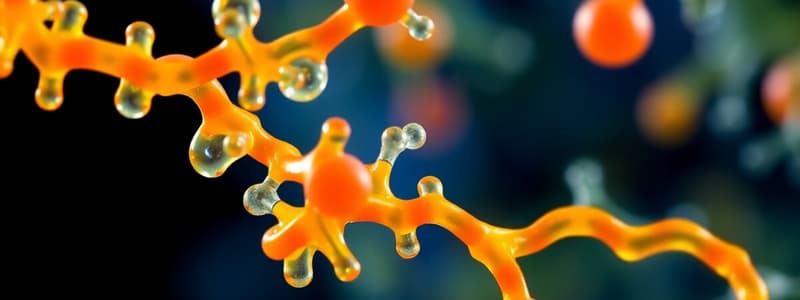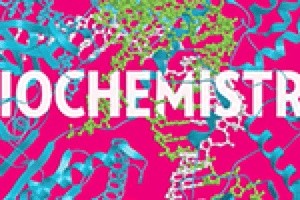Podcast
Questions and Answers
What is the general reaction for the hydrolysis of carbohydrates?
What is the general reaction for the hydrolysis of carbohydrates?
- R''-R' → R'OH + R''H + H₂O
- R''-R' + H₂O → R''OH + R'H (correct)
- R''-R' + H₂O → R'OH + R''H
- R''OH + R'H → R''-R' + H₂O
Which of the following enzymes is inhibited by the acidic environment of the stomach?
Which of the following enzymes is inhibited by the acidic environment of the stomach?
- Sucrase
- Maltase
- Salivary amylase (correct)
- Pancreatic amylase
During intestinal formation of monosaccharides, which of the following enzymes is NOT one of the four key enzymes involved?
During intestinal formation of monosaccharides, which of the following enzymes is NOT one of the four key enzymes involved?
- Sucrase
- Amylase (correct)
- α-dextrinase
- Lactase
Where does the digestion of proteins into 2-3 amino acid polypeptides primarily occur?
Where does the digestion of proteins into 2-3 amino acid polypeptides primarily occur?
Which of the following characteristics is associated with pancreatic lipase?
Which of the following characteristics is associated with pancreatic lipase?
What is the estimated surface area of the total absorptive epithelium in the small intestine?
What is the estimated surface area of the total absorptive epithelium in the small intestine?
What primarily drives water absorption in the small intestine?
What primarily drives water absorption in the small intestine?
What stimulates trans and paracellular water absorption?
What stimulates trans and paracellular water absorption?
Secretion of bicarbonate is driven by which of the following?
Secretion of bicarbonate is driven by which of the following?
Which transport mechanism is responsible for fructose absorption in the intestinal lumen?
Which transport mechanism is responsible for fructose absorption in the intestinal lumen?
Which class of transporters is primarily responsible for mediating the transport of peptides and amino acids?
Which class of transporters is primarily responsible for mediating the transport of peptides and amino acids?
By what process are free fatty acids (FFAs) generated by lipases absorbed across the Brush Border Membrane (BBM)?
By what process are free fatty acids (FFAs) generated by lipases absorbed across the Brush Border Membrane (BBM)?
Which of the following best describes how digested fats are transported away from the intestine?
Which of the following best describes how digested fats are transported away from the intestine?
What percentage of fecal matter is composed of dead bacteria?
What percentage of fecal matter is composed of dead bacteria?
Which anatomical feature of the small intestine is responsible for increasing the surface area by approximately 1000-fold?
Which anatomical feature of the small intestine is responsible for increasing the surface area by approximately 1000-fold?
Which of the following enzymes is a collagenase that functions optimally at a pH of 2-3?
Which of the following enzymes is a collagenase that functions optimally at a pH of 2-3?
How does the liver facilitate iron absorption in the small intestine?
How does the liver facilitate iron absorption in the small intestine?
Why is lymphatic transport essential for absorption of long-chain fatty acids (LCFAs) compared to short-chain fatty acids (SCFAs)?
Why is lymphatic transport essential for absorption of long-chain fatty acids (LCFAs) compared to short-chain fatty acids (SCFAs)?
A patient presents with diarrhea due to excessive secretion of ions in the intestine. If the diarrhea is caused by a bacterial infection, which mechanism links the bacteria to increased ion secretion?
A patient presents with diarrhea due to excessive secretion of ions in the intestine. If the diarrhea is caused by a bacterial infection, which mechanism links the bacteria to increased ion secretion?
A researcher is investigating the absorption of a novel disaccharide in the small intestine. They discover that the disaccharide is hydrolyzed by an enzyme located within the enterocyte, rather than on the brush border membrane. Which of the following scenarios would most likely result from this unusual location of hydrolysis?
A researcher is investigating the absorption of a novel disaccharide in the small intestine. They discover that the disaccharide is hydrolyzed by an enzyme located within the enterocyte, rather than on the brush border membrane. Which of the following scenarios would most likely result from this unusual location of hydrolysis?
Flashcards
Macronutrient Digestion
Macronutrient Digestion
Breaking down carbohydrates, lipids, and proteins into smaller, absorbable molecules.
Amylases
Amylases
Enzymes that catalyze the hydrolysis of carbohydrates into simpler sugars.
Intestinal Disaccharidases
Intestinal Disaccharidases
Four key enzymes (lactase, sucrase, maltase, α-dextrinase) act in the brush border to break down disaccharides into monosaccharides for absorption.
Peptidases
Peptidases
Signup and view all the flashcards
Fat Digestion
Fat Digestion
Signup and view all the flashcards
Intestinal Surface Amplification
Intestinal Surface Amplification
Signup and view all the flashcards
Absorption in Small Intestine
Absorption in Small Intestine
Signup and view all the flashcards
Colonic Absorption
Colonic Absorption
Signup and view all the flashcards
SLC Transporters
SLC Transporters
Signup and view all the flashcards
Fat Absorption Process
Fat Absorption Process
Signup and view all the flashcards
Study Notes
Macronutrient Digestion
- Hydrolysis of carbohydrates requires H₂O
- General reaction for carbohydrate hydrolysis: R"-R' + H2O -> R"OH + R'H
- Hydrolysis of lipids generally involves triglycerides (TG)
- Triglyceride hydrolysis releases 3 free fatty acids (FFA) and glycerol at the brush border
- Hydrolysis of proteins/peptides is also a key part of macronutrient digestion
Carbohydrate Digestion
- Amylases are the primary enzymes involved
- Saliva (α-amylase) is inhibited by the acidic environment in the stomach
- Pancreatic amylase is more active
- It is predominately duodenal and generates maltose
Intestinal Formation of Monosaccharides
- Four key enzymes for this process: lactase, sucrase, maltase, and α-dextrinase
- These are produced from enterocytes and act at the brush border
- Lactose is broken down into fructose + glucose
- Sucrose is broken down into fructose + glucose
- Absorption happens into the intestinal epithelium
- Transport occurs across the basolateral surface
- Monosaccharides enter the circulation through the portal vein and are directed immediately to the liver
Digestion of Proteins
- Connective tissues must be digested to release the content of animal tissue
- Collagen is digested by pepsin, which is a collagenase that functions best at a pH of 2-3
- Elastin undergoes a two-step conversion: Proelastase -> Elastase
- Polypeptides are generated, and peptidases such as aminopolypeptidase & dipeptidase in the enterocytes of the Brush Border
- About 2-3 AA polypeptides are absorbed
- Intracellular peptidases release AA during absorption
Digestion of Fats
- Lipases are a large family of fat-metabolizing enzymes
- Pancreatic lipase involves hydrolysis, requires H2O, and functions at a neutral pH
- Bile and agitation emulsify fats.
- The enzyme is released in the duodenum
- Most absorption happens in the upper small intestine
- The enzymes act at the surface of the droplet
Anatomical Basis of Absorption
- Normal absorption involves about 1.5L of intake and 7L of GI secretions, totaling 8-9L
- Surface epithelium is maximized by Kerckring folds, intestinal villi, and brush border
- The brush border consists of the surface of villi and fingerlike projections, enriched in transport enzymes
- Total absorptive epithelium has ~1000X surface of intestinal length & circumference, estimated at 250 sq m
Absorption in Small Intestine
- Capacity is in excess of average daily intake (5-10 fold depending on the macronutrient)
- Active transport of Na+ drives secondary active transport for other ions, glucose, & AA
- Water absorption is driven by osmosis, passive & bidirectional
- Water moves transcellularly and paracellularly and is stimulated by aldosterone
- Colon is the most active area for water absorption
Chloride & Bicarbonate
- Chloride absorption follows an electrochemical gradient
- It drive secretion of bicarbonate, which is important for digestion.
- Bicarb is reabsorbed via formation of carbonic acid and free diffusion of CO2 back across the epithelium
- Extreme secretion causes diarrhea because active secretion of ions causes water to follow, can be stimulated by bacteria or Cholera Toxin
Other Key Ions
- Calcium is absorbed in the duodenum and stimulated by PTH & VitD
- Iron is absorbed using Transferrin, which is secreted by the liver into bile and then internalized by the Transferrin Receptor
- K+, Mg2+, PO4 absorption is active
- Monovalent ions are absorbed more than Bivalent ions
Monosaccharides
- CHO must be converted to monosaccharides for absorption
- Absorption involves active and passive processes and it is generally active at the apical and passive at the basolateral membrane
- Circulation and insulin action maintains gradient at basolateral surface
- SGLT1 is not equal to SGLT2
Peptides & AA
- Absorption involves secondary active transport
- Tripeptides, dipeptides, and AA are absorbed using 10+ transporters
- Transporters can be neutral or charged (anionic vs. cationic)
- Classified under the SLC Class of transporters
Fat Absorption
- Lipases generate FFA (free fatty acids) which freely diffuse across BBM (brush border membrane)
- Esterification occurs in the enterocyte by Acyl CoA Synthetases (fatty acid trapping)
- Reticular Enzymes MGAT and DGAT generate TGs
- TGs are packaged in very large vesicles in the Golgi
- Occurs through lymphatic transport
- It is too large to enter portal circulation and bypasses the liver, being directed to the arterial circulation
Colonic Absorption & Excretion
- Potential for large loss of water & electrolytes due to gastric secretions
- The large intestine contributes to active recovery of ions and Osmotic reabsorption of water
- Microbial metabolism occurs and contributes to generation of Vit K & B12, Thiamine, Riboflavin, Methane, and SCFA
- Faces are 30% dead bacteria, 10-20% inorganic matter, 30% insoluble fiber, 5-10% fat, and 2-3% protein
Studying That Suits You
Use AI to generate personalized quizzes and flashcards to suit your learning preferences.




